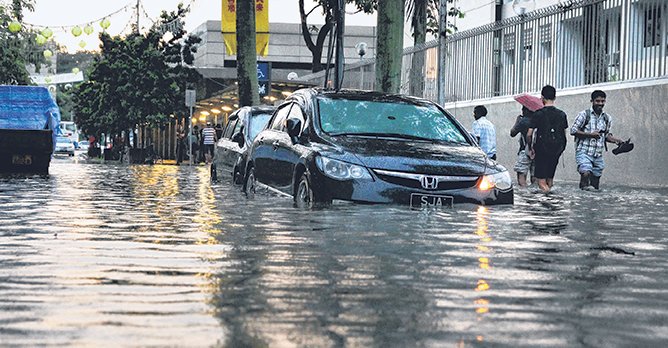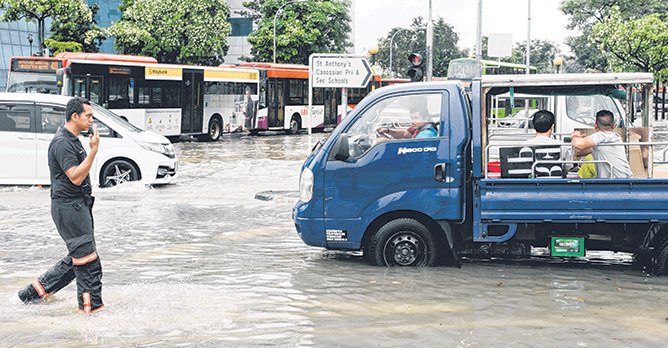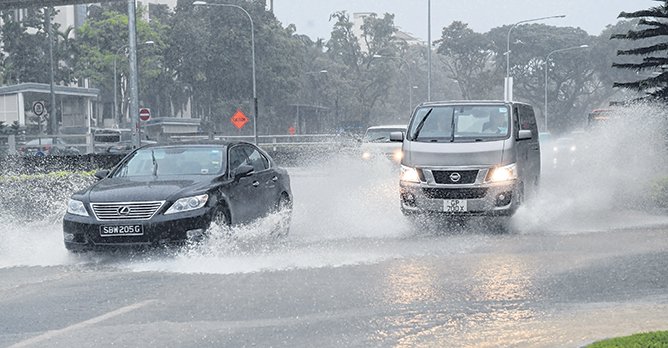Here's how to drive through flooded roads
07 Aug 2020|7,464 views
Every so often, Singapore will be showered with a thundery storm. They say it happens during the monsoon season, so I went online and did some research. Apparently, Singapore experiences two monsoon seasons, separated by inter-monsoonal periods - all of which has 'thunderstorms' in their description…
Okay, so we get thunderstorms all year long, and understandably, roads can get flooded - not much of an issue if you are lying in bed, but a huge issue if you are driving into it! Fret not, with this guide, the next time you face a flooded section of road, you will know what to do.
Assess the depth of water and the path to take
When you approach a flooded section of road, don't dive in headfirst! What you should do is to avoid going through standing water and take an alternative route or lane if you can. If there is no other option than to drive through a flooded area, you should try to gauge the water level by surrounding objects such as kerbs, barriers, traffic lights and road signs. If the water is up to the bottom edge of your car's doors, it is probably too precarious to carry on.
You should also observe how other vehicles are coping with it before you decide to ford the flooded section. Remember, do not attempt to cross the flooded area if there is no way to tell where the road leads or if there are any obstacles - the last thing you want is to end up crashing into a kerb, or driving off the road while fording through the water.
Gentlemen, rev your engines! (and approach slowly)
When it comes to driving through floods, the order of the day is to not let your engine ingest any water. To prevent water from entering the intake tract of your vehicle, you should keep to a low speed. Travelling at high speed in the water can create a bow wave which can splash about, increasing the odds of water getting into your car's engine. The next step is to keep the revs of your engine high to maintain a strong exhaust flow, reducing the probability for water to seep in and cause the engine to stall, or worse, hydrolock.
The best way to achieve this is to use a low gear, such as the first gear, which will allow you to travel at slow pace while maintaining considerable revs. If your car has a manual transmission, you can also keep the revs high by slipping the clutch or clutching in if you are forced to stop while still in the water.
Oh no! The engine died

The next consideration is whether to stay in your car, or to step out. This highly depends on how deep the water is and how the situation is likely to evolve. Opening the door of your vehicle might allow water to enter the car and ruin the interior, and it might even be dangerous for you! Generally, unless the water level seems to be getting way out of hand, staying in your car till help arrives will likely be the safer bet.
Everything went well, you crossed the flooded area, hooray! Wait a minute!
So, you took all the necessary precautions, and managed to cross the flooded stretch of road without stalling the engine, great! But don't celebrate just yet.
Right after you have forded through the water, you should test your brakes, and engage it several times to wick off the moisture in order to ensure that it is working fine before you continue with your journey. Also remember to test and check all lights and indicators on your car - electronics don't really like water that much.
The flooded stretch is in the rearview, right?
Just because your car survived the 'river crossing' doesn't mean it came out unscathed. Driving through flood water can damage your car, you should start off with an exterior check to see if the bodywork and paint of your vehicle has sustained any damages. Next up is the interior, in case you you didn't know, water and car interiors aren't a good match. It is a surefire way to bring up the stench in your car.
If your car is known to leak engine oil or transmission fluid, you should also get the fluids checked - water might have seeped into the engine and/or gearbox of your vehicle. If there are any part of your car that feels off, or if it is making some unfamiliar, suspicious noise, you should send it in to a workshop for a check.
Here are some related articles that might interest you
Don't get caught without proper car insurance coverage!
Car insurance quotes comparison: are you getting ripped off?
Common car insurance myths debunked! Know them and drive with a peace of mind
Got into an accident? Here's how to ensure a smooth insurance claim process
9 ways to lower your car insurance premiums

Sgcarmart
Get up to 20% off and $300 cashback when you renew with select car insurance!
Compare car insurance effortlessly with Sgcarmart. Get exclusive offers, discounts and cashback when renewing car insurance with our partner.
- Auto comparison for your future renewal quotes
- We provide claims support for your accident claims
Every so often, Singapore will be showered with a thundery storm. They say it happens during the monsoon season, so I went online and did some research. Apparently, Singapore experiences two monsoon seasons, separated by inter-monsoonal periods - all of which has 'thunderstorms' in their description…
Okay, so we get thunderstorms all year long, and understandably, roads can get flooded - not much of an issue if you are lying in bed, but a huge issue if you are driving into it! Fret not, with this guide, the next time you face a flooded section of road, you will know what to do.
Assess the depth of water and the path to take
When you approach a flooded section of road, don't dive in headfirst! What you should do is to avoid going through standing water and take an alternative route or lane if you can. If there is no other option than to drive through a flooded area, you should try to gauge the water level by surrounding objects such as kerbs, barriers, traffic lights and road signs. If the water is up to the bottom edge of your car's doors, it is probably too precarious to carry on.
You should also observe how other vehicles are coping with it before you decide to ford the flooded section. Remember, do not attempt to cross the flooded area if there is no way to tell where the road leads or if there are any obstacles - the last thing you want is to end up crashing into a kerb, or driving off the road while fording through the water.
Gentlemen, rev your engines! (and approach slowly)
When it comes to driving through floods, the order of the day is to not let your engine ingest any water. To prevent water from entering the intake tract of your vehicle, you should keep to a low speed. Travelling at high speed in the water can create a bow wave which can splash about, increasing the odds of water getting into your car's engine. The next step is to keep the revs of your engine high to maintain a strong exhaust flow, reducing the probability for water to seep in and cause the engine to stall, or worse, hydrolock.
The best way to achieve this is to use a low gear, such as the first gear, which will allow you to travel at slow pace while maintaining considerable revs. If your car has a manual transmission, you can also keep the revs high by slipping the clutch or clutching in if you are forced to stop while still in the water.
Oh no! The engine died

The next consideration is whether to stay in your car, or to step out. This highly depends on how deep the water is and how the situation is likely to evolve. Opening the door of your vehicle might allow water to enter the car and ruin the interior, and it might even be dangerous for you! Generally, unless the water level seems to be getting way out of hand, staying in your car till help arrives will likely be the safer bet.
Everything went well, you crossed the flooded area, hooray! Wait a minute!
So, you took all the necessary precautions, and managed to cross the flooded stretch of road without stalling the engine, great! But don't celebrate just yet.
Right after you have forded through the water, you should test your brakes, and engage it several times to wick off the moisture in order to ensure that it is working fine before you continue with your journey. Also remember to test and check all lights and indicators on your car - electronics don't really like water that much.
The flooded stretch is in the rearview, right?
Just because your car survived the 'river crossing' doesn't mean it came out unscathed. Driving through flood water can damage your car, you should start off with an exterior check to see if the bodywork and paint of your vehicle has sustained any damages. Next up is the interior, in case you you didn't know, water and car interiors aren't a good match. It is a surefire way to bring up the stench in your car.
If your car is known to leak engine oil or transmission fluid, you should also get the fluids checked - water might have seeped into the engine and/or gearbox of your vehicle. If there are any part of your car that feels off, or if it is making some unfamiliar, suspicious noise, you should send it in to a workshop for a check.
Here are some related articles that might interest you
Don't get caught without proper car insurance coverage!
Car insurance quotes comparison: are you getting ripped off?
Common car insurance myths debunked! Know them and drive with a peace of mind
Got into an accident? Here's how to ensure a smooth insurance claim process
9 ways to lower your car insurance premiums

Sgcarmart
Get up to 20% off and $300 cashback when you renew with select car insurance!
Compare car insurance effortlessly with Sgcarmart. Get exclusive offers, discounts and cashback when renewing car insurance with our partner.
- Auto comparison for your future renewal quotes
- We provide claims support for your accident claims

























